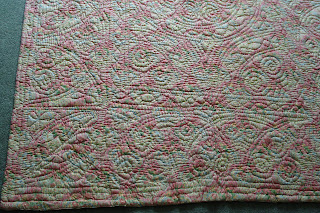
Karin and Alexander Hellaby (of Quilters Haven, Wickham Market)
.jpg)
Hawaiian quilt from afar at FOQ
.JPG)
A Raffle to win a pennant...

The finished Allendale stall - two north country quilts plus two Welsh quilts on the table
 Filming at the V & A stall for Twisted Thread
Filming at the V & A stall for Twisted Thread
 The V & A stall, where the cute trolleys had sold out by Saturday, and where price adjustments were welcomed by some and infuriated others...
The V & A stall, where the cute trolleys had sold out by Saturday, and where price adjustments were welcomed by some and infuriated others...
 Jane Rollason and Michel - the Welsh quilts were off to her Exhibition in the Heart of the Vineyards - 18/19 September 2010.
Jane Rollason and Michel - the Welsh quilts were off to her Exhibition in the Heart of the Vineyards - 18/19 September 2010.
 Susan Briscoe and her lovely Japanese fabrics
Susan Briscoe and her lovely Japanese fabrics
 An example of a kimono and obi using Susan's fabrics
An example of a kimono and obi using Susan's fabrics
 Welsh quilt made of dyed fabrics, by Hazel Ryder - made to celebrate 25th wedding anniversary
Welsh quilt made of dyed fabrics, by Hazel Ryder - made to celebrate 25th wedding anniversary
 The Hawaiian quilt
The Hawaiian quilt
 Hanging the Allendale quilts
Hanging the Allendale quilts
I've returned from the Festival of Quilts - four days plus half a day to set up - and really enjoyed it - but more work than I had envisaged. And unlike many others, I didn't have to sell anything or teach! But, I really enjoyed talking to everybody about the antique quilts.
I arrived on Wednesday afternoon - the main problem was getting the two quilts hung -it didn't take long once the team had arrived. The table was a bit nasty looking and I had not brought a cloth to put on it - but I decided to fling the turkey red Welsh quilt over it and that worked well. I had brought the Welsh quilts to hand over to Jane Rollason and I was able to drape a Welsh quilt over the table each day.
Most of the interest centred around quilt marking methods, how long did it take you?, where I had gotten the quilt, how to wash quilts, tracing quilt designs and quilting in a frame.
I was also pleased to see that my Hawaiian quilt looked very good when hung and had arrived safely. The traditional category covered a lot of quilts, some more traditional than others; it was noticeable that none of the winning quilts were hand quilted. As Lilian has noted, a truly traditional quilt scores low on creativity so has a lesser chance of winning.
I was pleased to read the judges comments (always food for thought) one said "great visual impact, excellent applique, well quilted" while the other said "very well executed and excellent hand quilting". This year and the two previous years, the edge treatment has not been marked as high; I know that I could get it really right but as I'm still working I just feel I don't want to spend my time in that way. It was also interesting to note that, as the ventilation was so fierce at the NEC, by the final day almost all the quilts had rippling edges - luckily they were still OK when they were being judged on the first day!
I include some photos but I didn't take too many! The artificial light doesn't seem to work too well with my camera - or perhaps I had the wrong setting....
At the end I was a bit worried about collecting the Hawaiian quilt and also taking the Allendales down. I had no Phillips screwdriver to unfasten the battens from the display boards - but a couple of hard, swift pulls on the battens was enough to bring them down safely (made me feel like a real action woman). The quilt collection was the usual chaos - but I was able to collect the quilt and leave by 6 so was home at 9.15.
I did wonder on Saturday whether my voice would last - I am not used to talking so much!! Very pleased at meeting everyone and startled that there are so many who read (and apparently enjoy) this blog. My main aim was to promote antique British quilts - I know that they're not everyone's cup of tea - but think that I succeeded, together with the museum stall which had a nice selection of wholecloths. Well worth doing.





 Karin and Alexander Hellaby (of Quilters Haven, Wickham Market)
Karin and Alexander Hellaby (of Quilters Haven, Wickham Market)
.jpg)
.JPG)



















.jpg)






.jpg)









